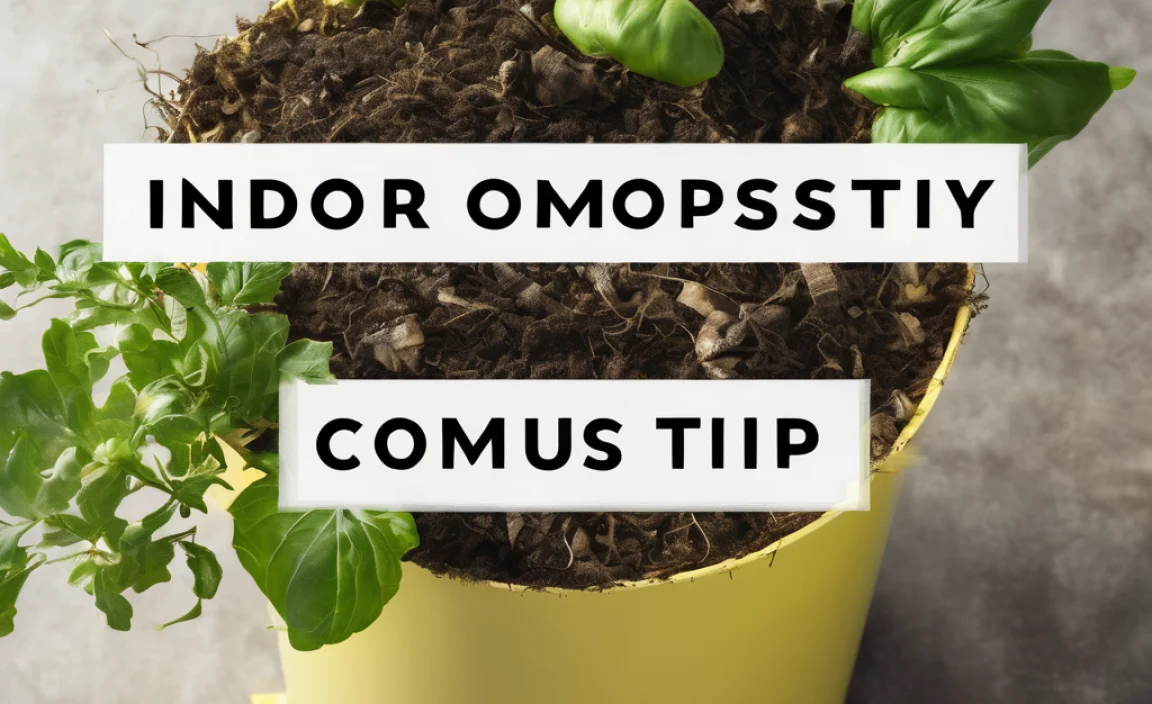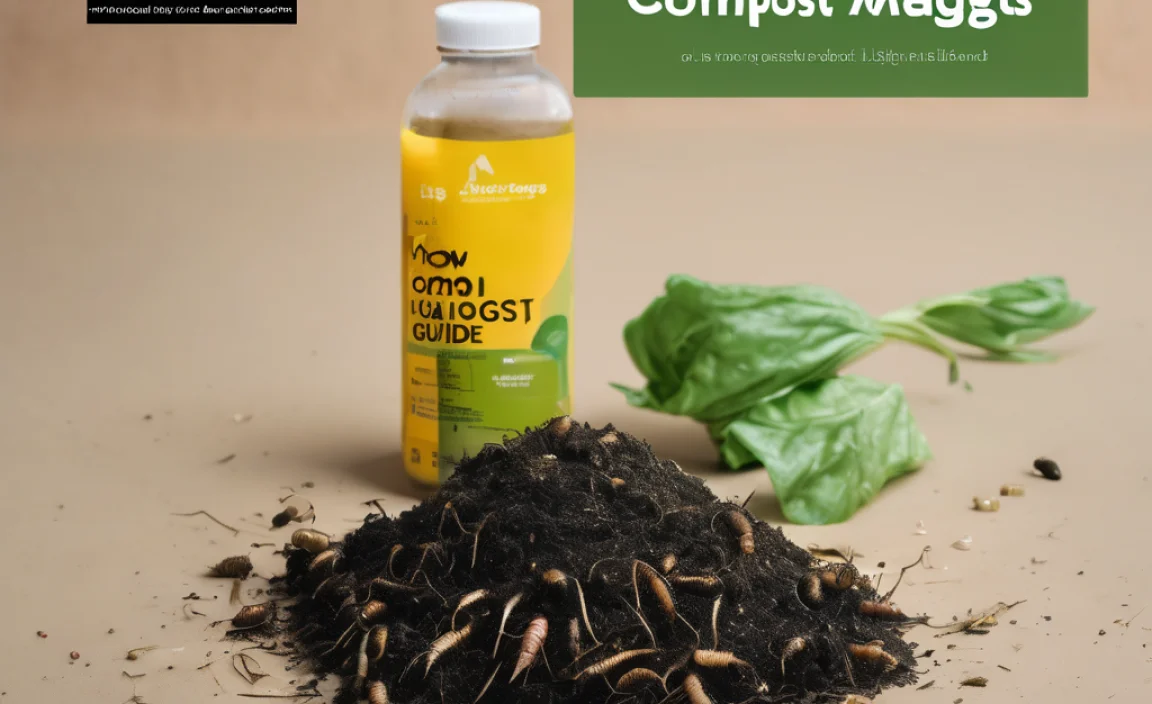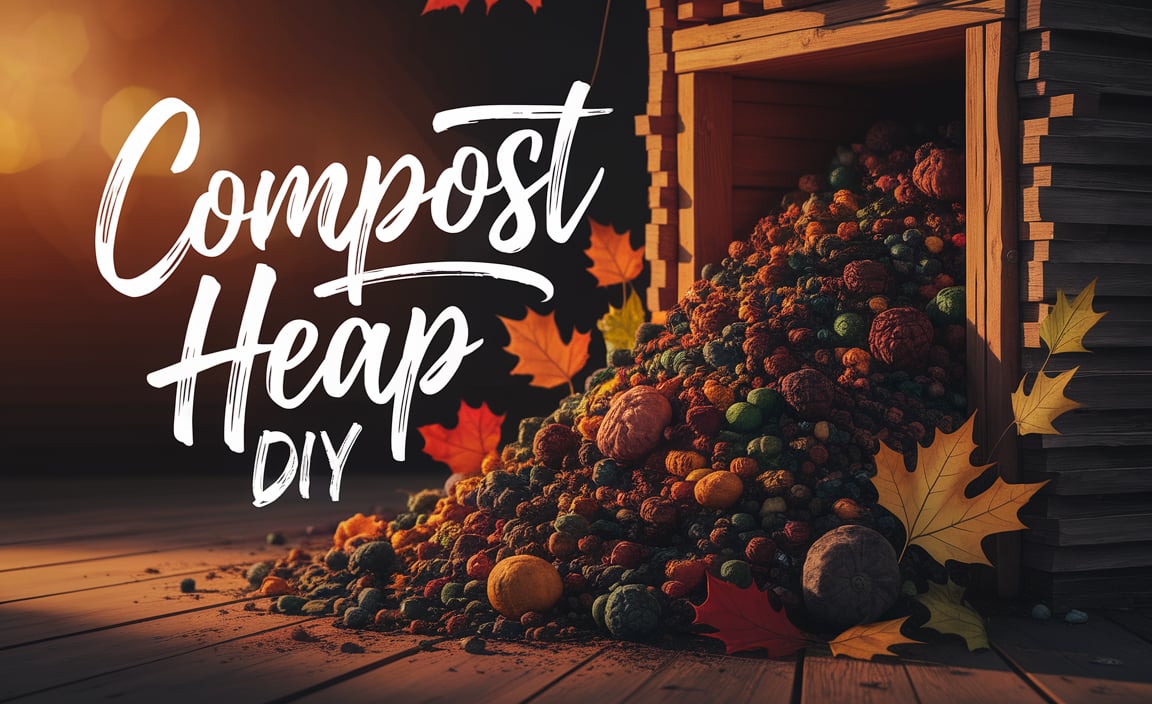Ever wonder what’s really going on in your compost bin? It might seem like magic, but it’s actually tiny helpers at work! These microscopic buddies break down your kitchen scraps and yard waste into nutrient-rich compost. In Canada, understanding these compost microbes is key to turning your waste into garden gold. Don’t worry if this sounds complicated; we’ll break it down step-by-step. Let’s dig in and unlock the secrets of your compost pile!
Compost Microbes in Canada: Your Essential Guide to a Healthy Pile
Hey there, fellow Canadians! Troy D Harn here from TopChooser, your go-to friend for all things DIY, gardening, and making your home life a little easier. Today, we’re diving deep into the fascinating world of compost microbes right here in Canada. If you’ve ever felt a bit overwhelmed by composting, or just curious about what’s actually happening in that bin, you’ve come to the right place. We’re going to demystify these tiny powerhouses and show you how to create a thriving compost ecosystem in your own backyard.
Composting is one of the most rewarding things you can do for your garden and the environment. It reduces landfill waste and produces fantastic fertilizer for your plants. But the real stars of the show are the microbes – the bacteria, fungi, protozoa, and nematodes that do all the heavy lifting. Understanding them is like getting a backstage pass to the composting process. And guess what? It’s not as complicated as it sounds. We’ll cover the essentials, from what they are to how to keep them happy, no matter what Canadian climate you’re dealing with.
What Are Compost Microbes, Anyway?
Think of compost microbes as nature’s tiny recycling crew. They are living organisms, too small to see without a microscope, that are responsible for breaking down organic matter. This “matter” includes everything from your apple cores and coffee grounds to grass clippings and fallen leaves. Without these microbes, your compost pile would just sit there, slowly rotting!
There are four main types of players in this microscopic decomposition team:
- Bacteria: These are the most abundant microbes in a compost pile. They are the initial decomposers, working quickly on simple sugars and starches.
- Fungi: Fungi, like molds and yeasts, are excellent at breaking down tougher materials like woody stems and lignin. They work alongside bacteria.
- Protozoa: These single-celled organisms feed on bacteria, helping to regulate bacterial populations and releasing nutrients.
- Nematodes: These tiny worms also consume bacteria and other microbes, playing a role in nutrient cycling.
Together, these organisms transform your scraps into the dark, crumbly, sweet-smelling material we know and love as compost. It’s a complex and beautiful natural process that we can easily encourage.
Why Compost Microbes Matter for Canadians
In Canada, we experience a wide range of climates, from the humid east coast to the dry prairies and the cold, northern winters. This means we need to be mindful of how our composting methods can support these microbes year-round. A healthy population of microbes ensures that your compost breaks down efficiently, regardless of the season, and produces a high-quality end product.
Here’s why cultivating a thriving microbial community in your compost is crucial:
- Faster Composting: More active microbes mean quicker decomposition, turning your waste into finished compost in weeks or months, not years.
- Better Quality Compost: Active microbes produce nutrient-rich compost that’s great for your garden soil.
- Odor Control: A well-aerated and balanced compost pile, driven by healthy microbes, won’t smell bad. Bad smells often indicate an imbalance or lack of oxygen.
- Weed and Disease Suppression: The composting process, when done correctly, can kill weed seeds and harmful pathogens.
- Nutrient Cycling: Microbes unlock essential nutrients that plants need to grow, making your garden healthier and more productive.
The Ingredients of a Happy Compost Microbe Community
Just like you need the right ingredients for a good meal, compost microbes need specific conditions and food sources to thrive. Think of it as providing them with a balanced, tasty buffet and a comfortable home.
The “Greens” and “Browns” Balance
This is the golden rule of composting. You need a mix of nitrogen-rich “greens” and carbon-rich “browns.” Microbes use nitrogen for protein and growth, and carbon for energy.
Greens (Nitrogen-Rich):
- Fruit and vegetable scraps
- Coffee grounds and tea bags
- Grass clippings (in thin layers to avoid matting)
- Plant trimmings (non-woody)
Browns (Carbon-Rich):
- Dry leaves
- Shredded newspaper and cardboard (avoid glossy or colored inks)
- Straw and hay
- Wood chips and sawdust (in moderation)
A good starting ratio is roughly 2 parts browns to 1 part greens by volume. This might need tweaking based on what you’re composting. Too many greens can make the pile wet and smelly, while too many browns can slow down decomposition.
Moisture: The Microbe’s Drink
Microbes need moisture to live and work, but they don’t like to swim! The ideal moisture level is like a wrung-out sponge – damp, but not dripping wet.
- Too Dry? Decomposition slows dramatically. Add water, perhaps by hosing down the pile or adding moisture-rich greens.
- Too Wet? Microbes can drown, and anaerobic (oxygen-deprived) conditions set in, leading to stinky compost. Add dry browns and turn the pile to aerate it.
Airflow: The Microbe’s Breath
Most of the beneficial microbes in composting are aerobic, meaning they need oxygen. Turning your compost pile regularly is crucial for providing this air supply.
- Turning: Use a pitchfork or a compost aerator tool to mix the materials. This brings oxygen to the center of the pile, where it’s needed most.
- Compost Bins: Some bins are designed with aeration holes. You can also turn the materials within the bin.
Temperature: The Microbe’s Comfort Zone
Compost microbes work best within a certain temperature range. As they break down materials, they generate heat. A hot compost pile (130-160°F or 55-70°C) indicates that the microbes are working efficiently and can kill weed seeds and pathogens.
However, even cooler composting (passive composting) works, it just takes longer. In Canada, and especially during cooler months, maintaining high temperatures can be challenging. The key is to ensure the other factors (greens/browns, moisture, air) are balanced so that decomposition still occurs, even if slower.
Composting Methods for Canadian Climates
Your choice of composting method might depend on your space, time, and local climate. Here are a few popular options:
1. Outdoor Compost Bins (Open Piles or Tumblers)
This is the most common method for homeowners. You can build your own bin or buy a pre-made one.
- Open Piles: Simple heaps in a corner of your yard. Best for larger spaces.
- Enclosed Bins: Contain the materials and can look tidier. Many come with lids to deter pests.
- Tumblers: Sealed drums that you can rotate, making turning easy and speeding up the process.
Considerations for Canada: In colder climates, turning a large pile can be difficult in winter. Tumblers can be more manageable, and sometimes insulated bins help retain heat. Insulating your bin with straw bales or a tarp can help keep microbes active during longer winters.
2. Vermicomposting (Worm Composting)
This method uses specific types of worms (like red wigglers) to break down food scraps. It’s great for apartments or those with limited outdoor space, and it can be done indoors.
Considerations for Canada: Worms are sensitive to temperature. Indoor setups are ideal. Outdoor worm bins need to be heavily insulated and may go dormant or freeze in harsh Canadian winters, requiring specific management or bringing them indoors.
3. Bokashi Composting
Bokashi is an anaerobic (oxygen-free) fermentation process that uses a special inoculated bran or culture. It can handle meat and dairy, traditionally excluded from other compost methods, and works in any temperature.
Considerations for Canada: Bokashi is excellent for year-round composting, even in frigid temperatures. However, the fermented product still needs to be buried or added to a traditional compost pile to finish breaking down. It’s a great way to pre-process waste during winter months.
Troubleshooting Common Composting Issues in Canada
Even with the best intentions, sometimes compost piles can be a bit stubborn. Here are a few common problems and how to fix them, keeping Canadian conditions in mind.
Problem: My compost pile smells bad!
Cause: Usually, this is due to a lack of oxygen (anaerobic conditions) or too much nitrogen (too many greens). Ammonia smells mean excess nitrogen. Rotten egg or sulfur smells often mean it’s too wet and anaerobic.
Solution:
- Turn the pile to introduce air.
- Add more “browns” (carbon-rich materials like leaves, shredded paper) to balance the nitrogen and absorb excess moisture.
- Ensure the pile isn’t waterlogged.
Problem: My compost pile isn’t heating up or decomposing
Cause: It might be too dry, lack nitrogen (too many browns), or simply be too cold (especially in Canada during fall and winter).
Solution:
- Add water until it’s like a wrung-out sponge.
- Add more “greens” (nitrogen-rich materials like kitchen scraps or grass clippings).
- Turn the pile to aerate it.
- If its’ cold, try to insulate the pile with straw bales or a tarp to help it retain any heat generated. Smaller, actively managed piles can heat up better.
Problem: I’m attracting pests (raccoons, rats, flies)
Cause: Exposed food scraps, meat, or dairy can attract unwanted visitors.
Solution:
- Bury kitchen scraps deep within the pile under brown materials.
- Use an enclosed compost bin or tumbler.
- Avoid adding meat, dairy, and oily foods (unless using Bokashi).
- Ensure your bin has a secure lid.
Problem: My compost is taking forever to break down
Cause: A combination of factors: materials too large, not enough aeration, wrong moisture levels, or simply the cold Canadian weather.
Solution:
- Chop or shred larger items before adding them to the pile.
- Turn the pile regularly.
- Check and adjust moisture levels.
- Be patient, especially during colder months. Composting naturally slows down when temperatures drop. Consider what you add to the pile; some items decompose faster than others.
Tools and Materials for Canadian Composters
You don’t need a lot of fancy gear to start composting. Here are some essentials and nice-to-haves:
Essential Gear
- Compost Bin: A simple pile, a DIY wooden bin, an enclosed plastic bin, or a tumbler. For Canadian winters, consider a tumbler or an insulated bin. Check out resources from your local municipality; they often sell municipal compost bins at a discount.
- Pitchfork or Shovel: For turning the compost pile. A long-handled one is easier on your back.
- Gloves: To keep your hands clean.
- Water Source: A hose or watering can to add moisture.
Helpful Additions
- Compost Aerator Tool: A specialized tool designed to easily bring air into the center of a compost pile.
- Shredder: For breaking down brown materials like cardboard and leaves faster.
- Kitchen Compost Caddy: A handy bin to collect food scraps indoors before taking them out to the main pile.
- Thermometer: To monitor the internal temperature of your compost pile, if you’re aiming for hot composting.
Boosting Microbial Activity in Your Canadian Compost
Want to give your compost microbes an extra boost? Here are a few tips:
- Add Finished Compost: A shovel full of finished compost or healthy garden soil can introduce a diverse range of microbes to your new pile, kick-starting the process.
- Chop Materials Small: Smaller pieces have more surface area for microbes to attack, speeding up decomposition.
- Balance Greens & Browns: As mentioned, this is critical. Aim for that 2:1 brown-to-green ratio.
- Maintain Moisture: Keep it consistently damp.
- Aerate Properly: Turn your pile regularly, especially during active decomposition phases.
- Consider Activators (Use Sparingly): Sometimes, commercially available compost activators are used. These often contain beneficial microbes or nutrients to speed things up. However, if you have a good mix of greens and browns, moisture, and air, you likely won’t need them. A common, readily available “activator” is a sprinkle of manure or a handful of soil.
When is Compost Ready?
Finished compost is a marvel! It should be:
- Dark brown or black in color.
- Crumbly in texture.
- Earthy and pleasant-smelling, never sour or foul.
- Most of the original materials should be unrecognizable.
You should no longer be able to identify the original ingredients like banana peels or coffee grounds. If you can still see distinct pieces, it’s not quite ready yet. It might take anywhere from a few months to over a year, depending on your methods, materials, and Canadian climate.
Compost Microbes and Environmental Benefits in Canada
Composting is more than just making fertilizer; it’s a powerful act of environmental stewardship. In Canada, where we have vast natural landscapes and a strong desire to protect them, composting plays a vital role.
- Reducing Landfill Waste: Organic materials make up a significant portion of household waste. Composting diverts this from landfills, where it can produce methane, a potent greenhouse gas. The Government of Canada highlights the importance of reducing methane emissions.
- Improving Soil Health: Compost enriches soil with organic matter, which improves soil structure, water retention, and aeration. This is vital for healthy plant growth and reducing the need for chemical fertilizers.
- Sequestering Carbon: Healthy soil, boosted by compost, can help sequester carbon from the atmosphere, contributing to climate change mitigation.
- Conserving Water: Compost improves a soil’s ability to hold water, meaning you’ll need to water your garden less often.
A Quick Look at Microbial Life Stages
The microbial activity in your compost pile changes as it progresses. Understanding these stages can help you manage your pile better.




